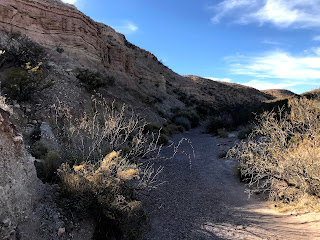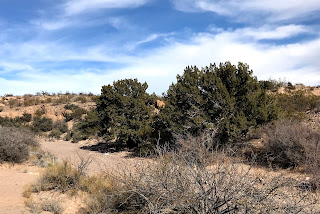Rincon Hills - Castle Tank Arroyo
My friends David and Nancy were willing to take chance with me so off we went on Sunday morning. The roads were good and ones I'd traveled on before and then came the moment to turn off into the unknown. First bad sign: we took off on wrong road and then had to backtrack. The one we wanted, I had studied as best I could on the satellite images and could see not one but several places where faint paths ( mostly likely made be ATV's) wandered off in order to circumvent nonexistent crossings of the steep-sided gullies and really in hindsight should probably have never even thought about doing. But, there we were coming upon the first of these quicker than expected ( and I already banged the rear end of the pickup crossing some lesser creases already!). We hem and hawed, debated and did not decide for quite awhile. I opined that it would be nice to have our bicycles for occasions such this and David agreed. David did a little shoveling and I did some more surveying, and then Nancy said while looking at On-X that this wasn't event the worst crossing we would face. Then we came to the conclusion that while we could make this one happen ( maybe) there was no point in doing it without seeing how bad the "bad" one was. We were about to start walking to it when Nancy said it was over a half mile away, and that's when I called it and we turned around. We had wasted enough time already. Or, so I thought.
Plan B had us driving on what was at first a good county road on the east side of the railroad tracks toward a trestle that goes over Castle Tank Arroyo close to its confluence with Rincon Arroyo. I had hoped to drive on the good road right next to the tracks, but alas, some very unfriendly signage ( even though the gate was unlocked) put us on parallel road on our side of the fence near the rails. It was questionable from the get-go and really it was no great surprise when it disappeared altogether still quite a distance from the hoped for trestle. Off we were, back around to Johnson Spring Arroyo.
Soon after we parked I found a piece of ancient pottery right in the old road. Up on the mesa I headed for the ridge while my friends studied an area of incredibly dense debitage. I found a few pieces of the coarsest type of brown pottery on the ridge (I failed to find any a few weeks earlier, so that was good), re- located the petroglyphs for my companions and then headed southeast, first to confirm the location of the second artifact site I had found previously, and then to head to Castle Tank Arroyo. I was a little worried, but then some bright sherds told me I was in the right place. I had hoped that Nancy and David would come out to this spot, but when I talked to David they were already headed north to a different part of the mesa.
The land lies really flat on both sides of Rincon Arroyo and the branches of Castle Tank were invisible as I headed toward them. I found more pottery and of course more lithics on the way.
A gate for an invisible road made going through the fence line easy and then I was in the shallowest reaches of the south branch. Seamus the Scottie and I were walking on bedrock much of the time from here. It appeared to be limestone, but whether it was a Paleozoic layer similar to outcrops in the main Caballos or perhaps a more recent ( as in a just a couple of million years ago) freshwater expression, I don't know. I do know we found no grinding holes in it anywhere.
We saw more javelina ( we had seen a few on our ascent to the mesa earlier). Their heavy black forms trotting off unhurriedly on a path out of the brushy, deepening canyon. There were scrub oaks, hackberries, junipers, squawbush and just about every kind desert shrub you might find, say up in the Organ Mountains, down here in the micro-climate of the this narrow desert canyon.
The going was very thick, and because I had to keep Seamus leashed up due to the javelina, awkward and even slow at times. He likes to play a game on me by lagging behind, or acting like he can't possibly see the best way to go through low growing brush in the hopes that I will get frustrated and take him off the leash, which I frequently do. This time, though, I wanted to play it safe for as long as I could stand it. There were a few overhangs and alcoves in the white rock layers that yielded only packrat nests upon investigation. We finally arrived at the confluence with the north branch where huge, pale boulders had tumbled from the cliffs and into the creek bed.
This is probably the deepest part of the canyon and I would've liked to have explored just little bit further down stream, but instead we headed up the north branch as planned. It was warm for a winter afternoon, and I had to give Seamus a long rest, plus lots of treats ( dipped in the oil from my canned oysters) and water while I ate my lunch, but he came through like the champ that he is.
Eventually we got out of the arroyo and followed a cow path to the tank where we rested a bit more at the mesquite trees there. Now we made the push back to our truck, as the sun dimmed and shadows lengthened. Our friends had gotten back much earlier and were well on their way home, by the time we arrived. It had been long day. In retrospect I wished I had not decided to try the roads that led to so much frustration. I may have also left off exploring the canyon to another day after getting such a late start, but that's what happens when you get turned away, you get more determined.
Labels: geology, hiking, petroglyphs, rockhounding, scenic driving










































































